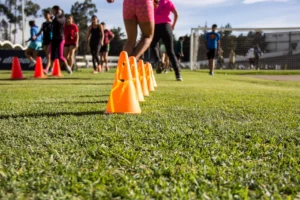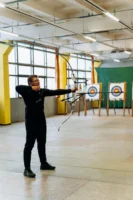
What if the key to becoming a two-way baseball god wasn’t just talent, but a series of almost superhuman, borderline-masochistic daily rituals?
While the world watches in awe as Shohei Ohtani simultaneously dominates the league as both an elite pitcher and a fearsome hitter, few understand the brutal, unconventional, and frankly forbidden training secrets that fuel his unprecedented success.
This article will pull back the curtain on the intense, lesser-known aspects of Ohtani’s daily grind, from his extreme drills to his monk-like discipline.
You’ll get an insider’s look at the specific methods considered too extreme for most athletes and the precise science behind why they work for him.
But a word of warning: do not, under any circumstances, try this at home.
The Dual-Path Daily Grind: A Schedule That Would Break Most Mortals

Ohtani’s day isn’t split into morning and afternoon; it’s split into two entirely separate athletic identities.
His routine is meticulously divided into “Pitcher Ohtani” and “Hitter Ohtani” blocks, each with its own brutal set of demands.
Imagine training for a marathon and a powerlifting competition on the same day, every day—that’s the level of compartmentalization we’re talking about.
This requires an insane level of physical and mental switching that is almost unheard of in modern sports.
The secret isn’t just doing both; it’s the scientific precision in the order and recovery windows between these intense sessions that prevents his body from completely breaking down.
Forbidden Drill #1: The Submarine Pitching Recovery

One of Ohtani’s most peculiar and guarded secrets is his post-pitching recovery session—in a pool.
But this isn’t a casual swim; he submerges himself in a deep pool and, from a standing position, goes through his entire pitching motion underwater.
The immense water resistance forces his muscles to work through the full range of motion without the destructive impact of landing on the mound.
This actives recovery drill flushes lactic acid, reinforces neuromuscular pathways, and maintains flexibility.
It’s a technique so niche and difficult to master that most trainers forbid it, fearing poor form could lead to serious shoulder injuries.
The 10-Hour Sleep Mandate & Nutritional Alchemy

While you’re scrolling through your phone at midnight, Ohtani has been asleep for hours.
His non-negotiable rule? A strict 10 hours of sleep every single night.
He treats sleep not as downtime, but as active recovery, understanding that human growth hormone (HGH) is primarily released during deep, sustained sleep cycles.
His diet is equally regimented, focusing on a specific ratio of macronutrients tailored to whether it’s a pitching or hitting day.
He consumes staggering amounts of high-quality protein and complex carbs, often through seven meticulously timed meals, to fuel and repair his dual roles.
The philosophy is simple: you cannot output superhuman performance without superhuman input and recovery.
The Insane Volume of “Teppo” Training

Forget the lightweight bats you see in the on-deck circle.
Ohtani’s “forbidden” hitting drill involves swinging a heavy, weighted “teppo” bat—a solid wooden club resembling a baseball bat—over 100 times a day.
This ancient Japanese training method builds incredible bat speed and functional strength when he switches to his standard 33-inch, 880-gram game bat.
The science is based on the principle of overload: training with extreme resistance makes game-speed movements feel effortless.
However, this extreme volume with a heavy implement is a fast track to oblique strains and rotational injuries for anyone without his foundational strength and technique.
Neuroplasticity Drills: Training The Brain

Ohtani’s training isn’t just physical; it’s profoundly mental.
He incorporates vision training drills designed to improve his pitch recognition, tracking a ball’s spin through specialized strobe glasses that obscure vision until the last millisecond.
Other drills involve reacting to random lights and sounds to sharpen his reflexes, honing his brain’s processing speed to match his body’s elite abilities.
This focus on neuroplasticity—the brain’s ability to rewire itself—is what allows him to seamlessly flip between the calm focus of a pitcher and the aggressive instinct of a hitter.
It’s a forbidden secret because most organizations still prioritize brute strength over cognitive athleticism.
Why You Shouldn’t Try This (The Professional Supervision Clause)

Here is the most critical part of this entire expose: Ohtani’s regimen is built for Ohtani.
He has a small army of specialists—from physiotherapists and nutritionists to biomechanists and coaches—constantly monitoring his every vital sign and movement pattern.
They adjust his workload in real-time based on data from wearable tech and daily blood tests, something an amateur simply cannot access.
Attempting his “teppo” swings or underwater pitching drills without this support system is a one-way ticket to a torn labrum, a herniated disc, or a career-ending injury.
His methods are forbidden for a reason: they exist on the very razor’s edge of peak performance and physical catastrophe.
The Takeaway: Philosophy Over Imitation

So, what can we learn from Shohei Ohtani’s forbidden secrets?
The real lesson isn’t to copy his drills, but to understand the underlying philosophy: a holistic, obsessive, and data-driven commitment to every facet of performance.
It’s about the aggregation of marginal gains—sleep, diet, recovery, mental training—that together create a monumental advantage.
His success is a testament to doing the ordinary things with extraordinary consistency and intensity.
While we can’t all be Shohei, we can all ask ourselves one revealing question: are we truly doing everything in our power, within our own limits, to be our best?
Maybe start with getting to bed on time.
Unlock Your Body’s Recovery Potential

So, you push your limits in the gym, but what happens when the workout ends?
For elite performers, the real magic happens during recovery, a process as crucial as the training itself.
Imagine a tool that acts like a personal massage therapist, meticulously guiding lactic acid out of your weary muscles.
This is the power of advanced Recovery Boots, a technology once reserved for top-tier athletes.
They work by using dynamic air compression to mimic the body’s natural circulatory patterns, dramatically reducing soreness and speeding up repair.
But what if you could harness this professional-grade advantage at home?
Now you can, with systems like the Therabody RecoveryAir JetBoots.
These boots offer a targeted, safer alternative to guesswork, providing a supervised recovery session on your schedule.
It’s not just about feeling less sore; it’s about waking up ready to conquer your next challenge, not dread it.
Ready to elevate your recovery game and invest in your body’s future?
Click here to learn how you can train harder and recover smarter today.

Leave a Reply